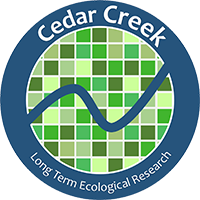This experiment consists of four separate experiments conducted during 1989 and 1990.
In 1989, forty eight windowscreen cages (40cm x 40cm at the base and 122cm tall) were placed over existing vegetation in the macro plots in Field B (see E004). Three replicate macroplots of each of two fertilizer treatments [control(treatment I) and 26g/m2 of ammonium nitrate and sufficient amounts of potassium, phosphorus, calcium, magnesium, and trace metals (treatment G)], i.e. a total of six macroplots, were used in the experiment.
Groups of 8 cages were placed 2m apart in a row 1m from the edge of a macroplot. Each cage within a macroplot was randomly assigned one of four treatments: (1) one grasshopper species by itself, (2) a second grasshopper species by itself, (3) both grasshopper species combined, and (4) no grasshoppers. For a given fertilizer treatment, there were six replicates of each grasshopper treatment, two on each macroplot. In 1990, cages were arranged in a completely randomized design within a single unfertilized macroplot (#6), with 8 replicates of each treatment. Cages were either unfertilized or fertilized with 28 g/m2 ammonium nitrate prior to stocking grasshoppers.
In both years, grasshoppers were stocked according to the assigned treatment and then proceeded to die off to a relatively constant average number per cage over the ensuing four weeks. Grasshopper numbers in each cage were counted every 3-5 days over this time period. When grasshopper numbers in each cage were constant in all treatments for 14 days, grasshoppers were counted a final time and the cages were pulled up. Vegetation was sampled after cages were pulled up within the 40cm x 40cm area contained by the cage. Plants were sorted to species, dried and weighed. The experiment was conducted at two different times (early and late in the summer) with different pairs of grasshopper species. On May 29, 1989, adult grasshoppers of two species (Arphia conspersa (AC) and Pardalophora apiculata (PA))were stocked in the cages according to the following densities: AC by itself, 5/cage; PA by itself, 4/cage; AC and PA together, 3 AC and 3 PA per cage.
Vegetation was sampled at the termination of the experiment on June 25, 1989. Grasshopper densities outside the cages were sampled on May 23 and 24, 1989. After the first experiment, cages were set up on new plots 3m from the edge of the macroplot to avoid using vegetation disturbed by counting. On July 25, adult grasshoppers of two different species (Melanoplus femur-rubrum (FR) and Melanoplus bivattatus (BV)) were stocked according to the above treatments (randomly reassigned) in the following densities: FR by itself, 6/cage; BV by itself, 4/cage; FR and BV together, 4 FR and 3 BV /cage. Vegetation was sampled at the termination of the experiment on August 31, 1989.
In late May of 1990, grasshoppers were stocked in the following numbers in both fertilized and unfertilized plots: no grasshoppers (empty cages), AC by itself (5/cage), PA by itself (4/cage), and both species together (3 of each). With 8 replicates of each fertilizer x grasshopper combination, a total of 64 cages were used. Vegetation was sampled at the end of the experiment as in 1989.
In late July of 1990, two new grasshopper species were used in addition to Melanoplus femur-rubrum (MF): Phoetaliotes nebrascensis (PN) and Spharagemon collare (SC). Grasshoppers were stocked in the following numbers: no grasshoppers (empty cages), MF by itself (6/cage), PN by itself (10/cage), SC by itself (6/cage), MF + PN (3 MF and 5 PN per cage), MF + SC (3 of each per cage), SC + PN (3 SC + 5 PN per cage), and all three species together (2 MF, 2 SC, and 3 PN per cage). Vegetation was sampled at the end of the experiment as in 1989. At the end of the early and late 1990 experiments, a single soil sample was taken from each cage plot and analyzed for soil solution ammonium and nitrate with 0.02M KCl. For a list of treatments, see the treatment layouts in file trmte60.
